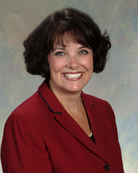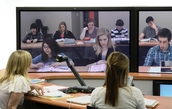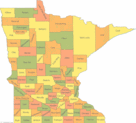 In a few days, we’re kicking off another round of affordable housing dialogues with our partners at the Greater Minnesota Housing Fund and the Minnesota Housing Finance Agency. It’s the third year that we’ve participated in these dialogues and I look forward to once again hitting the road with Warren Hanson and Mary Tingerthal to hear firsthand about the housing issues facing each region in rural Minnesota.
We’re also going to use these dialogues as an opportunity to learn more about each region’s housing priorities. Where do you think the funders should focus resources in the near future?
Currently, we’re using our housing programs at Rural Development to continue the country’s economic recovery.
We’re helping people buy homes so they can continue living, working and raising a family in rural Minnesota. We’re also helping current homeowners refinance existing loans or make essential home repairs so they can remain in rural Minnesota.
Home ownership is not right for everyone, which makes our multi-family housing programs so important. We oversee the management of almost 600 apartment complexes in rural Minnesota, providing over 11,000 units of safe and sanitary housing for low-income rural Minnesotans. Our priority right now in multi-family housing is to preserve the facilities that we currently have, making sure those 11,000 Minnesotans continue having a safe place to call home.
But that’s enough about us. I want to hear from you. And I know Mary and Warren do too. There’s more information on the housing dialogues, including registration information, later in this newsletter. I hope to see you there.
|
 It’s a normal day in Maureen Morrow’s Spanish class at Deer River High School in Northern Minnesota.
Ms. Morrow is teaching her students some new words. Students are repeating each word, trying their best to pronounce each one correctly and eventually use it in a phrase or sentence.
It seems like your typical high school Spanish class, except for the three large, high-definition television screens at the front of the classroom.
Students in classrooms at schools in Remer and Nashwauk-Keewatin are on the screen. They’re getting the same lesson from Ms. Morrow as the students in Deer River. They’re responding to Ms. Morrow’s questions and interacting, all in real time.
It’s called a telepresence classroom, and it allows rural schools to offer educational opportunities that otherwise might not be available.
USDA Rural Development State Director Colleen Landkamer visited Deer River High School and Ms. Morrow’s class on March 28 to award the Itasca Area Schools Collaborative (IASC) two grants totaling $1 million to expand its telepresence network.
IASC will use the grants to install distance learning technology in 21 schools in North Central Minnesota. The technology will result in additional courses, more educational opportunities, a video repository, ability to share resources, and training and collaboration opportunities.
“This type of technology prepares kids for a 21st century world,” IASC chair Matt Grosse said. “It helps them contribute to what is becoming a global society.”
There's only one student from Nashwauk-Keewatin participating in Ms. Morrow’s Spanish class. Without the distance learning technology, that student would not be able to enroll in a Spanish class because it would have been cancelled due to lack of interest.
“That’s a good illustration of the power of this type of program,” Grosse said. “This student had no other options for a Spanish class without this. We need to find ways to ensure these opportunities for kids.”
There are over 300 Native American students enrolled in Deer River High School. The technology also will be used to teach Native American language and cultural courses throughout the region. IASC hopes to add about 17 more courses overall.
Distance learning technology allows rural schools to provide many of the same opportunities found in urban schools. It also helps schools mitigate the impact of budget reductions on students and classrooms.
“We’re strongest as individual districts when we’re stronger together,” Grosse said. “It’s a system of education that really is world class.”
|
 USDA Rural Development, the Greater Minnesota Housing Fund and the Minnesota Housing Finance Agency are once again partnering to host a series of regional housing dialogues throughout rural Minnesota.
The dialogues are an excellent opportunity to discuss housing priorities in your region, challenges addressing issues related to housing, network, and interact with staff from Rural Development, GMHF and MHFA.
Be sure to register and participate in a dialogue in your region. It’s free and lunch will be provided.
Dates and locations for the dialogues are as follows:
· April 4: Mt. Iron, Mt. Iron City Building
· April 5: Bemidji, Hampton Inn
· April 13: Mankato, City Center Hotel
· April 17: Fergus Falls, Ottertail Power Company
· April 20: St. Cloud, Le St. Germain Suite Hotel
|
 John Miller got the call at 12:45 a.m. on Sept. 7, 2007.
Freeborn Lumber Company – the business John’s grandfather bought in 1946 and John purchased from his father in 1986 – was burning to the ground.
Less than 30 minutes later, the nearly 100-year-old building was destroyed. Lightning struck a phone line next to a gas line and that was it. Firefighters arrived less than five minutes after getting called, but there was nothing they could do.
So what does the owner of a business that’s been in the family for over 60 years do when the business burns down? He gets right back to work.
By 7 a.m. the next morning, John and his staff were using the old city hall building in town to fill orders and keep operating. John says he’s never had a “down” year and he wasn’t going to let a fire change that.
By April 14, 2008, Freeborn Lumber was building a new facility just down the road in the nearby town of Albert Lea. By Labor Day, all 20 employees were moved in.
Even though the new facility is bigger than the old one, John’s heating and cooling costs are about one-fourth of what he previously paid. Using a grant from USDA’s Rural Energy for America Program (REAP), John installed a geothermal system to become more energy efficient and reduce energy expenses. “We did a crash course on how to apply and wrote the application ourselves,” Miller said. “Without the REAP program, I’m not sure how feasible it would have been to do this.”
Freeborn Lumber's geothermal system consists of three water-to-water heat pumps and a horizontal bore earth loop field. The water-to-water heat pumps transfer energy from the earth to the building during the heating months, and reject energy into the earth during the cooling months.
Approximately two-thirds of the energy required for heating Freeborn Lumber's building comes from the ground while the other one-third is used in running pumps and compressors.
“It’s performing really, really well,” Miller said.
Freeborn Lumber designs and sells materials for new homes, kitchens, decks, patios, cabinets, ag buildings, flooring and outdoor living. It’s a rural and family business success story and the success doesn’t appear to be slowing down anytime soon.
“I’m honored that USDA played a role in helping Freeborn Lumber rebuild and become more energy efficient,” said Colleen Landkamer, Minnesota Rural Development State Director. “We’re using the energy we have right in our own backyard and helping a rural business. That’s a definite win-win.”
|
Applications are being accepted for the traditional Rural Community Development Initiative (RCDI) program and the RCDI Rural Jobs Accelerator (RJA).
More information can be found in the Federal Register. Applications are due May 9, 2012. In Minnesota, applications must be submitted to Terry Louwagie in our state office (375 Jackson St., Suite 410, St. Paul, MN, 55101). USDA Rural Development plans to award up to $8.6 million through the RCDI program. Applications are sought for projects that:
- Provide technical assistance to improve the capacity of local organizations to complete successful housing, economic development and community facilities projects;
- Help recipients complete pre-development requirements – such as architectural and engineering plans;
- Help development organizations improve their board operations, management and knowledge of financial and information technology systems;
- Provide homeownership education or training for entrepreneurs.
Applications for Jobs Accelerator projects must be submitted to both USDA and the EDA. More information can be found at Grants.gov.
 Be sure to check out our website for a county-by-county map of all the revolving loan funds in Minnesota overseen by USDA Rural Development. The map is completely cickable and searchable and has contact information and eligibility requirements for all of our revolving loan funds.
What is a revolving loan fund? Rural Development has several programs that award funding to an itnermediary, typically a local government, nonprofit or utility cooperative.
The intermediary uses the funds to establish a revolving loan fund and make low-interest loans to ultimate recipients. Ultimate recipients include area small businesses or economic development projects.
As each ultimate recipient repays its loan, the intermedary makes additional loans to help more rural businesses and economic development projects.
Revolving loan funds are perfect for small businesses looking to grow or access working capital. Funds also can be combined with private financing from a traditional lender such as a bank or credit union.
We also added several new brochures that highlight our business programs, including programs that award loans and grants to establish revolving loan funds. Check out the brochrues section of our website. |
The Minnesota Council for Affordable and Rural Housing (MNCARH) will host its 2012 Annual Conference and Meeting on May 8-9, 2012, at the Grand Conference Center and Casino in Hinckley, Minn.
Please contact Katie Langer at 800-944-3078 or mncarh@gmail.com for more information. |